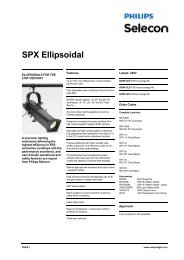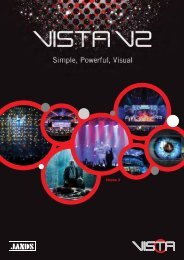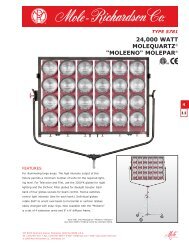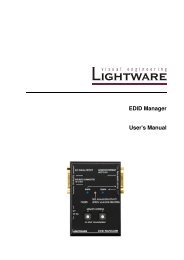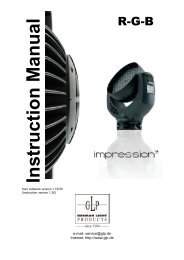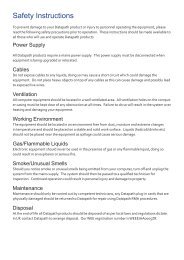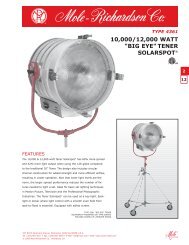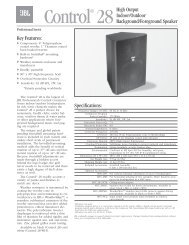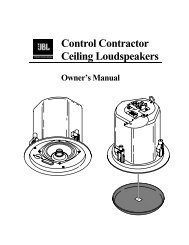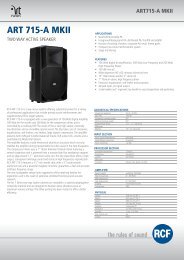Create successful ePaper yourself
Turn your PDF publications into a flip-book with our unique Google optimized e-Paper software.
The standards stay,<br />
but innovation never ends.<br />
The pursuit of perfection is ongoing and will probably never end, but along<br />
the way Yamaha has introduced a number of innovations that have become<br />
industry standards offering performance and familiarity that discerning users<br />
continue to demand. By definition, “standards” are best kept as they are. With<br />
evolutionary refinements, of course.<br />
Yamaha CL series digital mixing consoles represent a new level of refinement.<br />
They offer an evolved experience in accessible mixing, plus sonic purity with<br />
sound shaping capabilities that will give the most imaginative engineer<br />
unprecedented creative freedom. The CL series embodies the leading<br />
standards in live sound in their most advanced, most expressive form.<br />
DIGITAL MIXING CONSOLE CL5 / CL3 / CL1<br />
I/O RACK Rio3224-D / Rio1608-D<br />
01
A creative console for<br />
expressive engineering<br />
Efficient, enjoyable operation<br />
Scalable, versatile<br />
network capabilities<br />
Every engineer, artist, and audience<br />
agrees that sound quality is the bottom<br />
line. That’s a given. Through thorough<br />
analysis, review, and refinement of every<br />
detail of the circuitry and technology<br />
used, Yamaha CL series consoles deliver<br />
naturally superior sound plus a<br />
comprehensive range of “coloring”<br />
options that give the sonic craftsmen who<br />
will use them extraordinary creative<br />
freedom. The signal processors provided<br />
are plentiful and of the highest quality,<br />
including extraordinary Portico 5033/5043<br />
EQ and compressor devices that bring<br />
Yamaha VCM technology together with<br />
the legendary talents of Rupert Neve. The<br />
platform is pure and natural, so the<br />
engineer can create and deliver the ideal<br />
sound.<br />
Premium Rack Centralogic Rio3224-D<br />
A truly useful sound reinforcement<br />
console is one that can keep pace with the<br />
rapidly and dramatically changing<br />
demands of live sound applications.<br />
Efficient, intuitive operation is essential.<br />
Yamaha’s acclaimed Centralogic concept<br />
is the core of a refined user interface that<br />
offers a new, unprecedented level of<br />
operating efficiency in the CL series, from<br />
visual feedback right down to the form<br />
and feel of the faders and controls. The CL<br />
consoles are also ready for seamlessly<br />
integrated remote control and offline<br />
editing via an Apple iPad® or other<br />
computer. Control is familiar and intuitive,<br />
while at the same time offering extensive<br />
freedom.<br />
Network capabilities are rapidly becoming<br />
fundamental and indispensable in today’s<br />
fast-paced world of digital live sound. CL<br />
series consoles feature separate console<br />
and I/O rack components that<br />
communicate via the Dante network<br />
audio protocol, allowing fast, efficient<br />
design and deployment of capable<br />
systems from the most basic to the<br />
dazzlingly complex. The ability to add<br />
Lake® processing via expansion slots also<br />
adds to the system’s versatility and<br />
adaptability to the widest range of mixing<br />
needs.<br />
02
DIGITAL MIXING CONSOLE<br />
With a three-section fader layout for efficient hands-on<br />
control, the CL5 is the ideal choice for a diverse spectrum of<br />
live sound systems.<br />
• Input channels: 72 mono, 8 stereo.<br />
• Fader configuration: 16-fader left section, 8-fader Centralogic section,<br />
8-fader right section, 2-fader master section .<br />
• Aluminum stay for iPad support.<br />
• Built-in meter bridge.<br />
DIGITAL MIXING CONSOLE<br />
Dual 8-fader sections in a space-saving<br />
console that can be used alone or cascaded<br />
to another CL console for input expansion.<br />
• Input channels: 48 mono, 8 stereo.<br />
• Fader configuration: 8-fader left section, 8-fader<br />
Centralogic section, 2-fader master section .<br />
• Meter bridge optional.<br />
Consistent Features & Performance<br />
24 mixes / 8 matrices *1 8 Premium Racks 300 Scene Memories<br />
Dante<br />
CL Editor<br />
All specifications other than channel capacity are consistent<br />
throughout the lineup, so you get the same capabilities and<br />
performance whichever model you choose for your application.<br />
This also means consistent performance and operation in<br />
systems that implement multiple consoles.<br />
16 DCAs /<br />
8 Mute Groups<br />
Input Delay<br />
Output Port Delay<br />
8 Effect Racks<br />
16 GEQ Racks<br />
Channel PEQ /<br />
Dynamics<br />
16 User Defined<br />
Keys<br />
4 User Defined<br />
Knobs<br />
Fader Bank<br />
USB Memory<br />
Recorder<br />
Dante<br />
Virtual Soundcard<br />
GPI *2<br />
CL StageMix<br />
Console File<br />
Converter<br />
3 MY Slots<br />
03<br />
Input to Matrix*2 GPI functionality to be supported in an upcoming firmware update.
DIGITAL MIXING CONSOLE<br />
An ideal blend of compact size and<br />
channel capacity for a variety of live and<br />
installed applications.<br />
• Input channels: 64 mono, 8 stereo.<br />
• Fader configuration: 16-fader left section,<br />
8-fader Centralogic section, 2-fader<br />
master section .<br />
• Aluminum stay for iPad support.<br />
• Meter bridge optional.<br />
I/O RACK<br />
Two I/O rack options support a wide range of applications.<br />
Two rack-mountable I/O units with different input and output capacities are<br />
available for use with the CL series consoles. The 5U size Rio3224-D provides<br />
32 ins, 16 outs, and four AES/EBU outputs, while the 3U size Rio1608-D has 16<br />
ins and 8 outs. Both types connect to the console via Dante network protocol<br />
for low-jitter, low-latency digital audio communication.<br />
Rear Panel<br />
Options<br />
Meter BridgeMBCL<br />
Power Supply PW800W<br />
Power Supply Link Cable PSL360<br />
Gooseneck Lamp LA1L<br />
MBCL<br />
04
S o u n d Q u a l i t y<br />
Creating the Ideal<br />
Natural Sound Platform<br />
The full impact of the most advanced digital audio technology<br />
available has been applied throughout the CL series to deliver<br />
natural sound that provides a perfect foundation for the artist’s<br />
and engineer’s imagination. This type of sonic quality cannot be<br />
realized through specifications alone. Repeated listening<br />
evaluations and refinements by some of the most reliable ears and<br />
respected minds in the business are an indispensable part of the<br />
process. The CL series digital mixing consoles are proof that the<br />
time and effort involved have been well spent.<br />
The Sound Is In the Details<br />
The challenge begins right from the console’s inputs. In<br />
order to achieve the required level of sound quality,<br />
individual components, power supply, grounding, circuit<br />
layout, mechanical construction, and countless other details<br />
of the initial input stages must be selected and designed<br />
with the utmost care. Listening evaluation becomes an<br />
important part of the development process right from this<br />
first stage as well. Changing even a single electronic<br />
component can alter the sound in unexpected ways, and the<br />
tiniest variations must be noted and evaluated as<br />
development proceeds. Extreme measures have been taken<br />
to maximize AD and DA conversion performance as well,<br />
right down to making detailed spectral analyses of the<br />
AD/DA master clock and adjusting the FPGA clock signal<br />
routing so that the most natural, musical sound is achieved.<br />
Another critical part of any audio system is the power supply.<br />
Of course the capacity of the supply is important, but so are<br />
the types of capacitors used, and the grounding must be<br />
engineered to ensure the lowest possible impedance. The<br />
resultant sound is an eminently natural representation of the<br />
input signal, providing an ideal foundation for processing<br />
and effects that will lead to the final, polished sound.<br />
05
S o u n d Q u a l i t y<br />
Prodigious Quality &<br />
Creative Potential<br />
In creating the best possible sound for a profusion of venues and artist<br />
requirements, sound engineers draw on their experience and imagination<br />
to make a multitude of practical as well as creative decisions. The<br />
engineer’s primary hands-on tool, the mixing console, must be able to<br />
accommodate them all. Of course the bottom line is sound quality, and<br />
this is just one of the areas in which the CL series consoles excel. They also<br />
feature some of the most advanced analog circuitry modeling technology<br />
available to add unprecedented character and shape to the sound as<br />
needed, while maintaining the utmost sonic quality.<br />
A Digital Approach to<br />
Acclaimed Analog Quality<br />
Rupert Neve is a legend. His contributions to the fields of audio<br />
recording and production began at the dawn of the era and<br />
continue to this day in the form of microphone preamplifiers,<br />
equalizers, compressors, and mixing consoles that are the gold<br />
standards of professional audio.<br />
Clearly Mr. Neve is very serious about his sound, so it’s an honor<br />
that he and his company, Rupert Neve Designs, have officially<br />
recognized Yamaha’s original VCM (Virtual Circuitry Modeling)<br />
technology as being the first of its kind that is capable of<br />
accurately modeling the rich, expressive analog sound they have<br />
championed for so long. With VCM technology, digital audio is at<br />
last capable of matching analog designs for sonic quality.<br />
VCM, developed by Toshi Kunimoto (“Dr. K”) and his team at Yamaha’s innovative “K’s Lab”<br />
division, is a circuit modeling concept that effectively simulates the most detailed<br />
characteristics of individual circuit components, right down to<br />
capacitors and resistors, resulting in astonishingly realistic<br />
circuit simulations that easily outclass conventional digital<br />
simulations. But accuracy isn’t the only consideration,<br />
musicality is essential as well, and VCM modeling delivers both.<br />
The CL series consoles come equipped with VCM models of the<br />
renowned Neve Portico 5033 equalizer and Portico 5043<br />
compressor/limiter, both developed through close cooperation<br />
with Rupert Neve Designs. A valuable range of other VCM<br />
equalizers, compressors, and studio-quality effects is also<br />
included. You will hear the difference.<br />
Toshifumi Kunimoto<br />
Engineering Manager at<br />
Corporate Research & Development Center<br />
06
O p e r a b i l i t y<br />
Centralogic at the Heart of<br />
an Evolved Interface<br />
Yamaha’s Centralogic user interface has already proven its value as the most user-friendly<br />
digital operating environment available, even for engineers who were previously only<br />
comfortable with analog consoles. Founded solidly on Centralogic roots, the CL series takes<br />
intuitive, efficient operation to an even higher level, offering an operating experience that<br />
engineers will not only feel immediately familiar with, but will be able to grow with into the<br />
future.<br />
Overview<br />
–Analog Style Intimacy<br />
Clear visual continuity from the Centralogic section’s<br />
physical faders to virtual on-screen controls via the<br />
console’s elegantly curved panel matches the<br />
unambiguous directness of analog console channel<br />
modules. Any of the console’s input and output<br />
channels can be instantly assigned to the Centralogic<br />
section in 8-channel groups.<br />
Selected Channel<br />
– Another Industry Standard from Yamaha<br />
The Selected Channel display provides a comprehensive<br />
view of the many controls and functions available for<br />
the currently selected channel. The corresponding<br />
physical controllers to the left of the display are labeled<br />
and laid out in the same way as the on-screen controls,<br />
for confident access and operation. The CL series<br />
includes a number of refinements to this now-standard<br />
interface for unprecedented operating ease.<br />
07
O p e r a b i l i t y<br />
Every Detail Designed for<br />
Optimum Operating Feel<br />
The way CL series functions and controls work together is a perfect<br />
example of how a whole can be greater than the sum of its parts. Within<br />
the larger framework of the user interface, the visibility, feel, and<br />
precision of individual faders, knobs, and switches are an essential part<br />
of the overall operating experience. The visual flow of the control layout<br />
across the consoles’ sweeping curves makes a significant contribution to<br />
smooth operation as well. The outstanding balance of the entire system,<br />
plus refinements such as programmable channel names/colors and user<br />
defined knobs, add up to operation that is, in a word, sublime.<br />
Newly Designed Faders<br />
No detail of form or function has been<br />
overlooked, right down to how the<br />
curvature of the elegant fader knobs<br />
comfortably fit the fingers at any angle.<br />
The fader knobs even have non-slip<br />
inserts that provide ideal friction for<br />
smooth, slip-free fades. Visibility is<br />
important too, so the knob edges are<br />
sculpted to provide a clear view of the<br />
fader scale from just about any angle.<br />
Editable Channel Names and Colors<br />
Editable channel name displays above each<br />
fader automatically switch to a larger character<br />
size for short names, and show pan and fader<br />
values as well. Below each channel name<br />
display is a color bar that illuminates in any of<br />
eight selectable colors, the same as those used<br />
in the central touch screen, for at-a-glance<br />
channel and group identification. Brightness<br />
can be adjusted for optimum visibility under<br />
any ambient lighting conditions.<br />
Direct Access to<br />
the Parameters You Need<br />
The User Defined Keys provided on Yamaha<br />
digital consoles are already a standard. The User<br />
Defined Knobs provided on the CL series<br />
consoles will quickly achieve the same status.<br />
Just about any of the console’s variable<br />
parameters can be assigned to the four User<br />
Defined Knobs for direct, instant access.<br />
Another advanced control feature is Custom<br />
Fader Bank selection, allowing the faders in each<br />
section to be instantly reordered as required.<br />
Harmony in Form and Function<br />
The sweeping form of the CL consoles is<br />
not only elegant, but it provides the best<br />
possible view of all controls and displays<br />
from the operator’s position. The visual<br />
continuity from the Centralogic faders to<br />
the display is seamless. The hand rest is<br />
genuine oak with a gorgeous ebony finish<br />
that matches the visual and tactile<br />
sophistication of the overall design.<br />
08
The CL series brings sublime sound together with operability that gives artists and engineers<br />
deep, intimate access to the full gamut of the system’s vast sonic capabilities with<br />
unprecedented directness and efficiency. This refined blend of sound and control delivers a truly<br />
musical mixing experience.<br />
10
F u n c t i o n a l i t y<br />
Dante for Fast,<br />
Flexible Networking<br />
The complexity and variety of today’s live sound systems makes fast,<br />
adaptable configuration and setup capability vital. Of course the highest level<br />
of sonic performance must be maintained at the same time. CL series consoles<br />
use the Dante network protocol developed by Audinate to allow flexible<br />
connection to multiple I/O rack units configured and located according to the<br />
needs of the application, while at the same time providing redundancy for<br />
superior reliability.<br />
Up to Eight I/O Rack Units<br />
Simple Setup<br />
Redundancy for Reliability<br />
11<br />
Dante directly supports star network<br />
configurations, so up to eight I/O rack units<br />
can be connected to any single CL series<br />
console and conveniently located wherever<br />
they are needed most. A few simple DIP<br />
switch settings are all that is required to<br />
change to daisy-chain networking as<br />
required.<br />
The ability to set up even complex systems<br />
quickly and easily is another benefit of Dante<br />
networking. In most cases devices on the<br />
network are recognized and set up<br />
automatically. And since patching operations<br />
that usually require a separate computer can<br />
be carried out directly from the CL console,<br />
changes to the initial setup are painless as well.<br />
Dante also makes it easy to maximize system<br />
reliability. Star networks allow the use of<br />
redundant primary and secondary lines for<br />
each device, for the utmost reliability in<br />
critical applications. With this type of setup a<br />
malfunction in a cable or other network<br />
component won’t bring the whole system<br />
down. The show will go on.
F u n c t i o n a l i t y<br />
Full Integration of<br />
FOH and Monitor Control<br />
Multiple CL series consoles can share control of the same I/O rack unit, allowing unprecedented system flexibility and efficient<br />
use of system resources. A new Gain Compensation function adds the ability to combine FOH and monitor control via a single<br />
network, for comprehensive digital live sound integration.<br />
I/O Rack Unit Sharing with<br />
Gain Compensation<br />
One obvious drawback of connecting<br />
multiple consoles to a single I/O rack unit<br />
is that gain adjustments made from one<br />
console can cause unexpected gain<br />
changes at the other consoles. The Gain<br />
Compensation function implemented in<br />
the CL consoles ensures that when the<br />
analog gain stage is adjusted from one of<br />
the consoles, corresponding<br />
compensation is automatically applied at the digital stage so that the level sent from the I/O<br />
rack unit to the connected CL consoles remains constant.<br />
Analog<br />
Gain<br />
Compensation<br />
Gain<br />
Stable<br />
Level<br />
FoH<br />
Digital Gain<br />
Monitor<br />
Digital Gain<br />
Digital Gain Control<br />
Gain compensation applied after<br />
any initial analog gain levels are set<br />
is carried out entirely in the digital<br />
domain. Digital gain control is<br />
another original CL series feature<br />
that contributes to extraordinarily<br />
smooth, efficient operation and<br />
integration of the entire system.<br />
12
F u n c t i o n a l i t y<br />
A Complete Live Sound Toolkit<br />
The quality and variety of internal effects have become major factors in choosing a digital live sound<br />
console. Studio quality sound is a must, but so is having the right processors for the job at hand. CL<br />
series consoles feature virtual effect racks that are packed with a selection of effects that have been<br />
chosen and developed to meet the real-world needs of live sound professionals. Everything you<br />
need to create perfectly polished sound for your application is right here.<br />
Premium Rack Brings<br />
Studio Standards to<br />
the Live Stage<br />
As the name implies, “virtual racks”<br />
provided in the CL series consoles let<br />
you combine signal processors you<br />
need for your application in one easily<br />
accessible location, much like<br />
traditional analog outboard racks. The<br />
new CL series Premium Rack can<br />
accommodate up to eight instances of<br />
the six expressive EQ and dynamics<br />
effects provided, including the Rupert Neve Designs Portico 5033 equalizer and Portico 5043<br />
compressor/limiter. The ability to use some of the most highly regarded studio effects in live<br />
mixes can help you deliver unprecedented sonic quality in any venue.<br />
Effect Rack With More Than 50 Effects<br />
In addition to the Premium Rack described above,<br />
the CL consoles feature an Effect Rack that allows<br />
simultaneous use of up to 8 effects from a selection<br />
of 46 ambience effects and 8 insertion effects, all of<br />
outstanding quality. Although a separate EQ rack is<br />
provided for the output buses, any of the 8 effects in<br />
the Effect Rack can be replaced by graphic EQ units<br />
as needed.<br />
32-channel Graphic Equalizer Rack<br />
The CL consoles also feature a GEQ rack that allows<br />
graphic EQ to be inserted into the output buses as<br />
required for room equalization and other functions.<br />
Up to 16 31-band GEQ units can be mounted in the<br />
rack for simultaneous use, and those GEQ units can<br />
be individually switched to Flex15GEQ mode,<br />
effectively providing two EQ channels that allow up<br />
to 15 bands to be used at a time. With a full rack of GEQ units all functioning in Flex15GEQ<br />
mode, you have a total of 32 GEQ channels for extensive equalization capacity.<br />
13
F u n c t i o n a l i t y<br />
A Comprehensive Range of Valued Devices<br />
VCM technology delivers refined, musical tonality in the outstanding lineup of devices provided in the CL series Premium Rack and Effect Rack.<br />
Portico5033<br />
Portico5043<br />
Premium Rack<br />
These devices<br />
immaculately model<br />
the full sonic depth<br />
and breadth of the<br />
original analog<br />
equalizer and<br />
compressor/limiter<br />
modules by Rupert<br />
Neve. They are not only ideal for adding first-class studioquality<br />
processor sound to your mix, but are also remarkably<br />
easy to set up for optimum effect. Merely inserting these<br />
outstanding models in the signal path can enhance the sound.<br />
U76<br />
Premium Rack<br />
A studio standard that is ideal for a wide range of applications.<br />
It even features a RATIO “ALL” button that simulates the effect<br />
of engaging all of the ratio buttons on the original.<br />
Opt-2A<br />
Premium Rack<br />
This is a model of one<br />
of the most widely used optical studio compressors from the<br />
1960’s. The distinctive and highly regarded compression and<br />
release characteristics of the original are recreated with<br />
remarkable precision.<br />
EQ-1A<br />
Premium Rack<br />
The classic studio<br />
equalizer that is the basis for this model is still in demand<br />
today, highly prized for the musical response of its vacuum<br />
tube and transformer EQ circuitry, as well as its distinctive<br />
boost/cut characteristics.<br />
Dynamic EQ<br />
Premium Rack<br />
An original dynamics<br />
processor that applies<br />
compression /<br />
expansion / limiting<br />
in response to level<br />
changes detected in<br />
specified frequency bands. A well designed interface makes<br />
achieving the ideal sound a fast, easy process.<br />
Comp 276<br />
Effect Rack<br />
This model is a<br />
composite of several analog compressors that were popular<br />
in recording studios in the 70’s. Anyone who is familiar with<br />
the originals will recognize the characteristic punch and<br />
fatness this device delivers.<br />
Open Deck<br />
Effect Rack<br />
Here’s a unique effect<br />
that models both the<br />
analog circuitry of<br />
well-known professional tape decks plus the characteristics of<br />
the tape used with them. You can simply choose a deck that<br />
offers the sound you need, or combine different recording and<br />
playback decks for a range of useful variations.<br />
Comp 260<br />
Effect Rack<br />
The compressor/limiter modeled in this device was all the<br />
rage in the late 70’s, featuring solid-state RMS level detection<br />
circuitry and VCAs for level control. The sonic signature of<br />
this model is unmistakable.<br />
EQ 601<br />
Effect Rack<br />
For a sweet analog<br />
EQ sound, this model<br />
recreates a popular<br />
circuit topology from<br />
the 70’s.<br />
14
F u n c t i o n a l i t y<br />
Two Ways to Record Live<br />
CL series consoles offer two live recording solutions: convenient 2-track<br />
recording direct to USB memory, and high-performance multitrack recording<br />
to a digital audio workstation via Dante. Whether it’s for a simple web upload,<br />
a commercial release, or just material to be used for a virtual sound check the<br />
next day, you have all the recording capability you need.<br />
Seamless Integration with Nuendo Live for<br />
Serious Multitrack Recording<br />
The Nuendo Live DAW application has been specifically designed for live multitrack<br />
recording, providing comprehensive control and overview for smooth operation<br />
under the most demanding live situations. An extension plug-in provides seamless<br />
integration with CL console features, such as channel<br />
names, markers, transport control, and more.<br />
*Appearance may differ in final version<br />
Dante Virtual Soundcard<br />
Dante Virtual Soundcard driver software enables direct multitrack recording to a<br />
Windows or Mac based DAW without the need for an audio interface between the<br />
console and computer. A high-performance DAW application such as Steinberg Nuendo<br />
Live can be used to record up to 64 tracks with studio quality and editing capabilities.<br />
Virtual Sound Check<br />
DAW playback can be instantly patched to the CL console’s input channels so that<br />
multitrack recordings can be used for “virtual” sound checks when the performers aren’t<br />
available. Recordings of the previous day’s performance can be used for sound check on<br />
the following day!<br />
Convenient 2-track Recording<br />
to USB Memory<br />
2-track recording in mp3 format couldn’t<br />
be easier. Simply plug a USB memory into<br />
the USB connector on the front panel of<br />
the console and start recording. No other<br />
equipment is required. Of course playback<br />
from the USB memory is possible as well<br />
in MP3, AAC, and WMA formats, making it<br />
a convenient source for BGM or sound<br />
effects.<br />
15
F u n c t i o n a l i t y<br />
Features Optimized<br />
for Live Sound<br />
Although there are as many ways to use a mixing console as there are sound engineers, extensive<br />
feedback from audio professionals has made it possible to provide a feature set that is ideally suited to<br />
the real-world needs of demanding live sound applications.<br />
300 Scene Memories<br />
Up to 300 console setups can be stored as<br />
“scenes” and instantly recalled whenever<br />
needed. Recall Safe, Focus, and Preview*<br />
functions are also provided.<br />
* To be supported in an upcoming firmware update.<br />
Versatile Input and Output Delays<br />
Up to 1000 ms delay on input channels<br />
facilitates precise microphone phase<br />
compensation, while up to 1000 ms delay<br />
on the output ports is useful for speaker<br />
distance compensation and room tuning.<br />
Ample EQ and Dynamics Processing<br />
All channels feature 4-band parametric EQ<br />
and two dynamics processors (one<br />
dynamic processor per output). The<br />
processors include an HPF for every input,<br />
and one also functions as a highly effective<br />
de-esser with advanced processing<br />
algorithms and a bandpass mode.<br />
16 DCA Groups<br />
16 DCA groups allow flexible grouping of<br />
multiple input channels for simultaneous<br />
control.<br />
5-in/5-out GPI Interface<br />
A 5-input/5-output GPI interface allows<br />
the CL consoles to respond to input from<br />
external switches, as well as to transmit<br />
on/off status to external devices.<br />
* To be supported in an upcoming firmware update.<br />
8 Mute Groups<br />
Multiple channels can be assigned to any<br />
of 8 mute groups for instant muting or<br />
un-muting, with a new Dimmer Level<br />
function.<br />
16 User Defined Keys<br />
A large number of console functions<br />
including Sends on Fader, Tap Tempo, and<br />
Set by Sel can be assigned to 16 User<br />
Defined Keys for instant hands-on access.<br />
Multiple User Key Sets<br />
Limited access to CL console functions can<br />
be provided for less experienced<br />
operators and accident prevention via<br />
multiple User Key sets that can be stored<br />
in the console itself* as well as on USB<br />
memory.<br />
* To be supported in an upcoming firmware update.<br />
Help File<br />
Simply tap the on-screen “Help” button to<br />
access the onboard operation manual.<br />
Once loaded all essential information is<br />
available directly via the console’s display,<br />
so you won’t need to keep the printed<br />
manual with you.<br />
16
A d d i t i o n a l F e a t u r e s<br />
New Remote Control Freedom<br />
With the CL StageMix application, an iPad becomes a wireless remote controller that can be used<br />
to set up and operate CL consoles from anywhere on stage or in the audience seating area.<br />
There’s even a built-in iPad stay on the CL5 and CL3 panels, providing a convenient mount for an<br />
iPad to be used for additional control functionality. There’s also the CL Editor application for<br />
computers running Windows or Mac operating systems, for both extended online operation and<br />
offline setup and editing. In addition to full Selected Channel and Overview display operation, the<br />
CL Editor facilitates scene data management, patch list editing, channel name editing, and much<br />
more. It’s even possible to use the CL StageMix and CL Editor applications at the same time.<br />
CL StageMix<br />
CL Editor<br />
Today’s Data for Tomorrow’s Show<br />
The Yamaha Console File Converter is an<br />
application that allows data to be shared between<br />
a number of Yamaha digital mixing consoles, and<br />
the CL series consoles are included in the latest<br />
version. You can share data between CL series,<br />
PM5D, M7CL, and LS9 consoles, so data from one<br />
show doesn’t have to be completely<br />
reprogrammed from scratch for the next, even if<br />
different consoles are used.<br />
LS9<br />
PM5D<br />
M7CL<br />
* CL StageMix can be downloaded from<br />
Apple's App Store at no charge.<br />
* Apple, the Apple logo, and iPad are trademarks of<br />
Apple Inc., registered in the U.S. and other countries.<br />
CL series<br />
17
A d d i t i o n a l F e a t u r e s<br />
Expandable and Adaptable<br />
Three Mini-YGDAI card slots on the CL consoles provide easy I/O expansion as well as extra<br />
processing capabilities. New additions to the expansion card lineup include an MY8-LAKE card<br />
that integrates Lake Processing, a staple in today’s live sound field, into the console, and a<br />
Dugan-MY16 card that adds the most advanced automated microphone cueing and gain control<br />
available.<br />
See the entire Mini-YGDAI card lineup at the Yamaha Pro Audio website : http://www.yamahaproaudio.com/<br />
Increased Power with Lake Speaker Processing Power<br />
Lake processing has become a standard for loudspeaker processing in live<br />
sound applications. An alliance between Yamaha and Lab.gruppen brings<br />
Lake Processing right into the CL series mixing consoles, via the MY8-LAKE<br />
expansion card. The MY8-LAKE card provides 8-in/8-out in Mesa (system EQ), 4-in/12-out<br />
Contour (crossover), and 4-in/4-out and 2-in/6-out Mesa & Contour (combination) modes.<br />
Although primarily intended for speaker processing, the asymmetrical Mesa EQ can also be<br />
very useful on input sources. The Lake Controller application running on a compatible<br />
computer allows management of multiple Lake devices in the system, while close<br />
compatibility with Smaart® Live<br />
contributes to smooth, efficient<br />
speaker system tuning.<br />
Cascade Link<br />
For applications that require a large number of input channels, CL consoles can be cascadeconnected<br />
via I/O cards such as the MY16-AE installed in their Mini-YGDAI expansion card slots.<br />
Mesa EQ Ideal Graphic EQ Linear Phase Crossover<br />
Automatic Gain Control for Up To 16 Microphone Inputs<br />
The Dugan-MY16 automatic mixer card, developed in<br />
cooperation with Dan Dugan Sound Design, provides smoothly<br />
automated microphone cueing and gain control for up to 16<br />
input channels. Rather than using gates to open and close channels, the Dugan system<br />
uses gain sharing and fades for smooth, natural level changes.<br />
18
System Examples: Live Sound<br />
Simple, flexible setup in any venue.<br />
A Simple Daisy-chain System<br />
Internal port switches allow the CL series to be easily set up for daisy-chain or star<br />
network configurations. In this example the Console at FOH position is directly<br />
connected to the I/O rack at the side of the stage. The network is self-configured. Of<br />
course the CL StageMix iPad app can be used even in simple systems like this one, and<br />
Dante Virtual Soundcard can be used to enable multitrack recording to a DAW such as<br />
Steinberg's Nuendo Live.<br />
A Flexible, Redundant Star Network<br />
Star topologies can be configured with gigabit network switches. In this configuration,<br />
redundant connections to each device on the network ensure that a malfunction in one<br />
cable or network device will not disrupt the entire system. The Gain Compensation<br />
feature allows multiple consoles to control analog gain for a single I/O rack, for seamless<br />
integration of FOH and monitor operation. Multiple computers can be used for live<br />
recording, too.<br />
<br />
<br />
SP2060<br />
Rio3224‐D Rio3224‐D Rio3224‐D<br />
CL3 Monitor<br />
AES/EBU<br />
Rio3224‐D<br />
CL StageMix<br />
PC for Live Recording<br />
Primary Switch<br />
Secondary Switch<br />
CL StageMix<br />
Primary Switch<br />
Secondary Switch<br />
<br />
<br />
<br />
<br />
<br />
<br />
CL StageMix<br />
CL5<br />
PC for Live Recording<br />
PC for Live Recording<br />
CL5<br />
FoH<br />
Rio1608‐D<br />
19
System Examples: Halls and Theaters<br />
Versatility and reliability for a wide range of applications.<br />
A Streamlined Multi-purpose Installation<br />
The ability to network with up to eight I/O racks located wherever they’re needed makes<br />
the CL series an excellent choice for halls and theaters that host a wide variety of shows.<br />
The I/O racks can be connected to any switch on the network, so the number of I/O racks<br />
used and their locations can be easily changed to suit different events.<br />
Multiple Consoles<br />
The CL series allows up to four CL consoles to be connected via a single Dante network.<br />
Each console on the network functions independently, allowing completely separate<br />
mixing to be carried out in a control room, on stage, and at FOH, for example. In situations<br />
like this the Gain Compensation feature prevents problems caused by unexpected analog<br />
gain changes from one console affecting the operation of others. In this example the FOH<br />
CL1 and CL5 are cascade connected to provide greater channel capacity.<br />
Rio1608‐D<br />
Rio1608‐D<br />
DME64N<br />
Rio3224‐D<br />
CL3<br />
Monitor<br />
Rio3224‐D<br />
Rio1608‐D<br />
Mobile I/O<br />
Rio1608‐D<br />
Rio1608‐D<br />
Primary Switch<br />
Rio1608‐D<br />
Primary Switch<br />
FoH<br />
CL StageMix<br />
Primary Switch<br />
CL5<br />
CL1<br />
<br />
<br />
<br />
Control Room<br />
Primary Switch<br />
PC for Live Recording<br />
CL5<br />
Rio1608‐D<br />
CL5<br />
Rio3224‐D<br />
Rio1608‐D<br />
20
CL5/CL3/CL1 Specifications<br />
General Specifications<br />
Sampling Frequency<br />
Signal Delay<br />
Fader<br />
Frequency Response<br />
Total Harmonic Distortion*3<br />
Hum & Noise*4<br />
Dynamic Range<br />
Crosstalk@1kHz<br />
Dimensions (WxHxD)<br />
and Net Weight<br />
Power Requirements<br />
(wattage)<br />
Power Requirements<br />
(voltage and hertz)<br />
Temperature Range<br />
Analog Input Characteristics<br />
Input Terminals GAIN<br />
Actual Load<br />
Impedance<br />
OMNI IN 1-8<br />
TALKBACK<br />
+66dB<br />
+18dB<br />
+17dB<br />
-6dB<br />
+64dB<br />
+20dB<br />
44.1kHz<br />
Internal<br />
48kHz<br />
44.1kHz<br />
±200ppm<br />
+4.1667%, +0.1%, -0.1%, -4.0%<br />
External<br />
48kHz<br />
±200ppm<br />
+4.1667%, +0.1%, -0.1%, -4.0%<br />
Less than 2.5ms, OMNI IN to OMNI OUT, Fs=48kHz<br />
100mm motorized, Resolution=1024steps, +10dB to -138dB, -∞dB all faders<br />
+0.5, -1.5dB 20Hz-20kHz, refer to +4dBu output @1kHz, OMNI IN to OMNI OUT<br />
Less than 0.05% 20Hz-20kHz@+4dBu into 600Ω, OMNI IN to OMNI OUT, Input Gain = Min.<br />
-128dBu typ., Equivalent Input Noise, Input Gain=Max.,<br />
-88dBu, Residual output noise, ST master off<br />
112dB typ., DA Converter,<br />
108dB typ., OMNI IN to OMNI OUT, Input Gain = Min.<br />
-100dB*1, adjacent OMNI IN/OMNI OUT channels, Input Gain = Min.<br />
CL5: 1053mm x 299mm x 667mm (41 1/2in x 11 3/4in x 26 1/4in), 36kg (79.4lb)<br />
CL3: 839mm x 299mm*2 x 667mm (33 1/8in x 11 3/4in x 26 1/4in), 29kg (63.9lb)*2<br />
CL1: 648mm x 299mm*2 x 667mm (25 5/8in x 11 3/4in x 26 1/4in), 24kg (52.9lb)*2<br />
CL5/CL3/CL1: 170W, Internal Power Supply<br />
CL5/CL3/CL1: 200W, Simultaneous use of Internal PSU and External PW800W<br />
US/Canada: 120V 60Hz, Japan: 100V 50/60Hz, China: 110-240V 50/60Hz<br />
Korea: 220V 60Hz, Other: 110-240V 50/60Hz<br />
Operating temperature range: 0 - 40, Storage temperature range: -20 - 60<br />
*1 Crosstalk is measured with a 30dB/octave filter @22kHz *2 Excluded MBCL optional meter bridge.<br />
*3 Total Harmonic Distortion is measured with 18dB/octave filter @80kHz*4 Hum & Noise are measured with A-Weight filter.<br />
10kΩ<br />
3kΩ<br />
10kΩ<br />
For Use With<br />
Nominal<br />
50-600Ω Mics &<br />
600Ω Lines<br />
50-600Ω Mics &<br />
600Ω Lines<br />
Sensitivity*1<br />
-82dBu (61.6µV)<br />
-34dBu (15.5mV)<br />
-33dBu (17.4mV)<br />
-10dBu (245mV)<br />
-70dBu (0.245mV)<br />
-26dBu (38.8mV)<br />
Input Level<br />
Nominal<br />
-62dBu (0.616mV)<br />
-14dBu (155mV)<br />
-13dBu (174mV)<br />
+10dBu (2.45V)<br />
-60dBu (0.775mV)<br />
-16dBu (0.123V)<br />
Max. before clip<br />
-42dBu (6.16mV)<br />
+6dBu (1.55V)<br />
+7dBu (1.74V)<br />
+30dBu (24.5V)<br />
-40dBu (7.75mV)<br />
+4dBu (1.23V)<br />
Digital Output Characteristics<br />
Terminal<br />
Format Data length Level Connector<br />
DIGITAL OUT AES/EBU AES/EBU Professional Use<br />
24bit RS422 XLR-3-32 type (Balanced)*1<br />
Connector<br />
DIN Connector 5P<br />
DIN Connector 5P<br />
BNC Connector<br />
BNC Connector<br />
D-Sub Connector 15P (Female) <br />
RJ-45<br />
XLR-4-31 type <br />
USB A Connector (Female)<br />
D-Sub Connector 9P (Female)<br />
Connector<br />
XLR-3-31 type (Balanced) *2<br />
XLR-3-31 type (Balanced) *2<br />
*1. Sensitivity is the lowest level that will produce an output of +4dBu(1.23V) or the nominal output level when the unit is set to maximum gain.(all faders and level controls are maximum position.)<br />
*2. XLR-3-31 type connectors are balanced..(1=GND, 2=HOT, 3=COLD) *3. In these specifications, 0dBu = 0.775 Vrms. *4. All input AD converters are 24bit linear, 128times oversampling.<br />
*5. +48V DC ( phantom power ) is supplied to OMNI IN (1-8) and TALKBACK XLR type connectors via each individual software controlled switches.<br />
Analog Output Characteristics<br />
Output Terminals<br />
Actual Source For Use With<br />
Output Level<br />
Impedance Nominal<br />
GAIN SW*5<br />
Connector<br />
Nominal Max. before clip<br />
+24dB (default) +4dBu (1.23 V) +24dBu (12.3 V)<br />
OMNI OUT 1-8<br />
75Ω 600Ω Lines<br />
XLR-3-32 type (Balanced)*1<br />
+18dB -2dBu (616mV) +18dBu (6.16V)<br />
8ΩPhones<br />
-<br />
75mW*6<br />
150mW<br />
PHONES<br />
15Ω<br />
Stereo Phone Jack (TRS) (Unbalanced)*2<br />
40ΩPhones<br />
-<br />
65mW*6<br />
150mW<br />
*1. XLR-3-32 type connectors are balanced.( 1=GND, 2=HOT, 3=COLD ) *2. PHONES stereo phone jack is unbalanced.( Tip=LEFT, Ring=RIGHT, Sleeve=GND ) *3. In these specifications, 0dBu = 0.775 Vrms.<br />
*4. All output DA converters are 24bit, 128times oversampling. *5. There are switches inside the body to preset the maximum output level. *6. The position of the level control is 10dB lowered from Max.<br />
Digital Input & Output Characteristics<br />
Terminal<br />
Format Data length Level Audio Connector<br />
Primary/Secondary Dante 24bit or 32bit 1000Base-T 64ch Input/64ch Output @48kHz etherCON Cat5e<br />
*1. XLR-3-32 type connectors are balanced. (1=GND, 2=HOT, 3=COLD)<br />
I/O Slot (1-3) Characteristics<br />
Each I/O Slot accepts a Mini-YGDAI card. Only Slot1 has a serial interface.<br />
Control I/O Characteristics<br />
Terminal Format Level<br />
MIDI<br />
WORD CLOCK<br />
IN<br />
OUT<br />
IN<br />
OUT<br />
GPI (5IN/5OUT)<br />
NETWORK<br />
LAMP (CL5=3, CL3=2, CL1=1)<br />
USB HOST<br />
Meter Bridge (CL3/CL1 only)<br />
MIDI<br />
MIDI<br />
-<br />
-<br />
-<br />
IEEE802.3<br />
-<br />
USB 2.0<br />
-<br />
-<br />
-<br />
TTL/75Ωterminated<br />
TTL/75Ω<br />
-<br />
10BASE-T/100Base-TX/<br />
0V - 12V<br />
-<br />
-<br />
*1. Input pins: Internal TTL-level pull-up resistors provided (47kΩ). Output pins: Open-drain output (Vmax = 12V, max. sink current/pin = 75mA)<br />
Power pins: Output voltage Vp = 5V, max. output current Imax = 300mA<br />
*2. Pin 4 = +12V, Pin 3 = GND, lamp rating 5W. Software voltage control.<br />
Rio3224-D/Rio1608-D Specifications<br />
General Specifications<br />
Sampling Frequency<br />
Signal Delay<br />
Frequency Response<br />
Total Harmonic Distortion*3<br />
Hum & Noise*4<br />
Dynamic Range<br />
Crosstalk@1kHz<br />
Dimensions (WxHxD)<br />
and Net Weight<br />
Power Requirements<br />
(wattage)<br />
Power Requirements<br />
(voltage and hertz)<br />
Temperature Range<br />
44.1kHz<br />
48kHz<br />
Internal<br />
88.2kHz<br />
96kHz<br />
44.1kHz<br />
±200ppm<br />
+4.1667%, +0.1%, -0.1%, -4.0%<br />
48kHz<br />
±200ppm<br />
+4.1667%, +0.1%, -0.1%, -4.0%<br />
External<br />
88.2kHz<br />
±200ppm<br />
+4.1667%, +0.1%, -0.1%, -4.0%<br />
96kHz<br />
±200ppm<br />
+4.1667%, +0.1%, -0.1%, -4.0%<br />
Less than 3ms INPUT to OUTPUT, connect with CL5 using Dante, Dante Receive Latency set to 0.25ms (one way), Fs=48kHz<br />
+0.5, -1.5dB 20Hz-20kHz, refer to +4dBu output @1kHz, INPUT to OUTPUT, Fs=44.1kHz, 48kHz<br />
+0.5, -1.5dB 20Hz-40kHz, refer to +4dBu output @1kHz, INPUT to OUTPUT, Fs=88.2kHz, 96kHz<br />
Less than 0.05% 20Hz-20kHz@+4dBu into 600Ω, Fs=44.1kHz, 48kHz<br />
Less than 0.05% 20Hz-40kHz@+4dBu into 600Ω, Fs=88.2kHz, 96kHz<br />
INPUT to OUTPUT, Input Gain = Min.<br />
-128dBu typ., Equivalent Input Noise, Input Gain=Max.<br />
-88dBu Residual output noise, ST master off.<br />
108dB typ., INPUT to OUTPUT, Input Gain = Min.<br />
-100dB*1, adjacent INPUT/OUTPUT channels, Input Gain = Min.<br />
Rio3224-D: 480mm x 232mm*2 x 361.5mm (18 7/8in x 9 1/4in x 14 1/4in), 12.4kg (27.3lb)<br />
Rio1608-D: 480mm x 144mm*2 x 361.5mm (18 7/8in x 5 3/4in x 14 1/4in), 8.8kg (19.4lb)<br />
Rio3224-D: 120W<br />
Rio1608-D: 70W<br />
US/Canada: 120V 60Hz, Japan: 100V 50/60Hz, China: 110-240V 50/60Hz<br />
Korea: 220V 60Hz, Other: 110-240V 50/60Hz<br />
Operating temperature range: 0 - 40<br />
Storage temperature range: -20 - 60<br />
*1 Crosstalk is measured with a 30dB/octave filter @22kHz *2 Including rubber feet. *3 Total Harmonic Distortion is measured with 18dB/octave filter @80kHz *4 Hum & Noise are measured with A-Weight filter.<br />
Analog Input Characteristics<br />
Input Level<br />
Input Terminals GAIN<br />
Actual Load For Use With<br />
Impedance<br />
Nominal<br />
Nominal<br />
Max. before clip<br />
Connector<br />
INPUT 1-16<br />
INPUT 17-32*5<br />
+66dB<br />
-62dBu (0.616mV) -42dBu (6.16mV)<br />
10kΩ<br />
+18dB<br />
50-600Ω Mics & -14dBu (155mV) +6dBu (1.55V)<br />
+17dB<br />
600Ω Lines -13dBu (174mV) +7dBu (1.74V)<br />
3kΩ<br />
-6dB<br />
+10dBu (2.45V) +30dBu (24.5V)<br />
+66dB<br />
-62dBu (0.616mV) -42dBu (6.16mV)<br />
10kΩ<br />
+18dB<br />
50-600Ω Mics & -14dBu (155mV) +6dBu (1.55V)<br />
+17dB<br />
600Ω Lines -13dBu (174mV) +7dBu (1.74V)<br />
3kΩ<br />
-6dB<br />
+10dBu (2.45V) +30dBu (24.5V)<br />
XLR-3-31 type (Balanced)*1<br />
XLR-3-31 type (Balanced)*1<br />
*1. XLR-3-31 type connectors are balanced.(1=GND, 2=HOT, 3=COLD) *2. In these specifications, 0dBu = 0.775 Vrms. *3. All input AD converters are 24bit linear, 128times oversampling.<br />
*4. +48V DC ( phantom power ) is supplied to INPUT XLR type connectors via each individual software controlled switch. *5. Rio3224-D only<br />
Analog Output Characteristics<br />
Output Terminals<br />
OUTPUT 1-8<br />
Actual Source<br />
Impedance<br />
75Ω<br />
For Use With<br />
Nominal<br />
600Ω Lines<br />
Max.Output Level<br />
OUTPUT 9-16*5<br />
75Ω<br />
600Ω Lines<br />
Select SW*4<br />
+24dB (default)<br />
+18dB<br />
+24dB (default)<br />
+18dB<br />
Output Level<br />
Nominal<br />
+4dBu (1.23 V)<br />
-2dBu (616mV)<br />
+4dBu (1.23 V)<br />
-2dBu (616mV)<br />
Max. before clip<br />
+24dBu (12.3V)<br />
+18dBu (6.16V)<br />
+24dBu (12.3V)<br />
+18dBu (6.16V)<br />
Connector<br />
XLR-3-32 type (Balanced)*1<br />
XLR-3-32 type (Balanced)*1<br />
*1. XLR-3-32 type connectors are balanced.( 1=GND, 2=HOT, 3=COLD ) *2. In these specifications, 0dBu = 0.775 Vrms. *3. All output DA converters are 24bit, 128times oversampling.<br />
*4. There are switches inside the body to preset the maximum output level. *5. Rio3224-D only<br />
Digital Input & Output Characteristics<br />
Terminal<br />
Format Data length Level Audio Connector<br />
Primary/Secondary Dante 24bit or 32bit 1000Base-T<br />
24ch Input/32ch Output (Rio3224-D)<br />
8ch Input/16ch Output (Rio1608-D)<br />
etherCON Cat5e<br />
Digital Output Characteristics<br />
Terminal<br />
Format Data length Level Connector<br />
AES/EBU OUT 1/2 - 7/8*1<br />
AES/EBU Professional Use<br />
24bit RS422 XLR-3-32 type (Balanced)*2<br />
*1 Rio3224-D only *2. XLR-3-32 type connectors are balanced.( 1=GND, 2=HOT, 3=COLD )<br />
21
Dimensions<br />
CL5 CL3 CL1<br />
15(5/8)<br />
15(5/8)<br />
15(5/8)<br />
299(11 3/4)<br />
201(8)<br />
299(11 3/4)<br />
201(8)<br />
299(11 3/4)<br />
201(8)<br />
839(33 1/8)<br />
130(5 1/4)<br />
Rio3224-D 5U Rio1608-D 3U MBCL<br />
480(18 7/8)<br />
220(8 3/4)<br />
12(1/2)<br />
5.7(1/4)<br />
232(9 1/4)<br />
350(13 3/4)<br />
361.5(14 1/4)<br />
5.8(1/4)<br />
480(18 7/8)<br />
132(5 1/4)<br />
12(1/2)<br />
144(5 3/4)<br />
667(26 1/4)<br />
667(26 1/4)<br />
667(26 1/4)<br />
1053(41 1/2)<br />
130(5 1/4)<br />
648(25 5/8)<br />
130(5 1/4)<br />
5.7(1/4)<br />
26(1 1/8)<br />
350(13 3/4)<br />
361.5(14 1/4)<br />
70(2 3/4)<br />
90.4(3 5/8)<br />
184.5(7 1/4)<br />
374(14 3/4)<br />
29.2(1 1/4)<br />
5.8(1/4)<br />
mm (inch)<br />
22
P.O. BOX1, Hamamatsu Japan<br />
www.yamahaproaudio.com<br />
*All specifications are subject to change without notice. *All trademarks and registered trademarks are property of their respective owners.<br />
LPA608<br />
Printed in Japan



